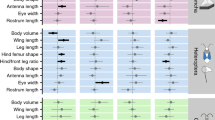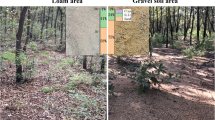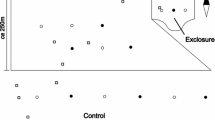Abstract
The purpose of this study was to investigate the effect ofchanges in landscape pattern on generalist and specialistinsects. We did this by comparing the species richness andabundance of generalist and specialist herbivorous insects inalfalfa (Medicago sativa, L.) fields on 26 agriculturallandscapes that differed in spatial structure. The insects werefrom the families Curculionidae (Coleoptera), weevils, andCicadellidae (Auchennorhyncha), leafhoppers.
We hypothesized that: (1) generalist richness and abundancewould be highest in landscapes with high diversity(Shannon-Wiener); (2) specialist richness and abundance would behighest in landscapes with (i) high percent cover alfalfa and(ii) low mean inter-patch distance. We tested for these effectsafter controlling for the patch-level effects of field size,field age, frequency of disturbance and vegetation texture.
The important findings of the study are: (1) generalist richness andabundance increased with increasing landscape diversity and (2)isolation (percent cover alfalfa in the landscape and/or meaninter-patch distance) does not affect specialist insects. Theseresults are significant because they indicate that bothgeneralist and specialist insects may move over much largerdistances than previously thought. This is one of the firststudies to demonstrate a large scale effect of spatial structureon insects across a broad range of landscapes.
Similar content being viewed by others
References
Andow, D.A. 1983. Effect of agricultural diversity on insect populations. InW. Lockeretz (ed.). Environmentally Sound Agriculture: 91–115. Praeger, New York.
Andrén, H. 1992. Corvid density and nest predation in relation to forest fragmentation: a landscape perspective. Ecology 73: 794–804.
Arnett, R.H., Jr. 1968. The Beetles of the United States (A manual for identification). American Entomological Institute. Ann Arbour, Michigan.
Bach, C.E. 1980. Effects of plant density and diversity on the population dynamics of a specialist herbivore, the striped cucumber beetle, Acalymma vittata(Fab.). Ecology 61: 1515–1530.
Bierne, B.P. 1956. Leafhoppers (Homoptera: Cicadellidae) of Canada and Alaska. The Canadian Entomologist Suppl. 2: 1–180.
Borror, D.J., C.A. Triplehorn and N.F. Johnson. 1989. An introduction to the study of insects, 6th edition. Saunders College Publishing, Toronto.
Bright, D.E. 1994. Revision of the genus Sitona (Coleoptera: Curculionidae) of North America. Annals of the Entomological Society of America 87: 277–306.
Brown, J.H. and A. Kodric-Brown. 1977. Turnover rates in insular biogeography: effect of immigration on extinction. Ecology 58: 445–449.
Chambers, J.M. and T. Hastie. 1989. Statistical models in S. Wadsworth & Brooks, Pacific Grove, CA, USA.
Clark, W.E. 1971. A taxonomic revision of the weevil genus Tychius Germar in America north of Mexico (Coleoptera: Curculionidae). Biological Series 13: 1–39.
Coll, M. and D.G. Bottrell. 1994. Effects of nonhost plants on an insect herbivore in diverse habitats. Ecology 75: 723–731.
Connell, J.H. 1978. Diversity in tropical rainforests and coral reefs. Science 199: 1302–1310.
Cromartie, W.J. 1981. The environmental control of insects using crop diversity. InD. Pimentel (ed.). CRC Handbook of Pest Management in Agriculture. Vol. 1: 223–250. Chemical Rubber Company, Boca Raton.
DeLong, D.M. 1971. The bionomics of leafhoppers. Annual Review of Entomology 16: 179–210.
Dunning, J.B., B.J. Danielson and H.R. Pulliam. 1992. Ecological processes that affect populations in complex landscapes. Oikos 65: 169–175.
Evans, E.W. 1983. The influence of neighbouring hosts on colonization of prairie milkweeds by a seed-feeding bug. Ecology 64: 648–653.
Fahrig, L. and I.D. Jonsen, In review. Effect of habitat patch characteristics on density and diversity of insects in farmland.
Fahrig, L. and G. Merriam. 1985. Habitat patch connectivity and population survival. Ecology 66: 1762–1768.
Fahrig, L. and G. Merriam. 1994. Conservation of fragmented populations. Conservation Biology 8: 50–59.
Fahrig, L. 1992. Relative importance of spatial and temporal scales in a patchy environment. Theoretical Population Biology 41: 300–314.
Flinn, P.W., A.A. Hower and R.A.J. Taylor. 1990. Immigration, sex ratio, and local movement of the potato leafhopper (Homoptera: Cicadellidae) in a Pennsylvania alfalfa field. J. Economic Entomology 83: 1858–1862.
Fortin, M.J., P. Drapeau and P. Legendre. 1989. Spatial auto-correlation and sampling design in plant ecology. Vegetatio 83: 209–222.
Hamilton, K.G.A. 1983. Introduced and native leafhoppers common to the Old and New Worlds (Rhyncota: Homoptera: Cicadellidae). The Canadian Entomologist 115: 473–511.
Hanski, I. 1994. Spatial scale, patchiness and population dynamics on land. Philosophical Transactions of the Roy-al Society of London B 343: 19–25.
Hastings, A. 1991. Stuctured models of metapopulation dynamics. Biological Journal of the Linnaean Society 42: 57–71.
Harrison, S. and C.D. Thomas. 1991. Patchiness and spatial pattern in the insect community on ragwort Senecio jacobaea. Oikos 62: 5–12.
Kareiva, P. 1983. Influence of vegetation texture on herbivore populations: resource concentration and herbivore movement. InR.F. Denno and M.S. McClure (eds). Variable Plants and Herbivores in Natural and Managed Systems: 259–289. Academic Press, New York.
Kareiva, P. 1990. Population dynamics in spatially complex environments: theory and data. Philosophical Transactions of the Royal Society of London B 330: 175–190.
Lande, R. 1988. Genetics and demography in biological conservation. Science 241: 1455–1460.
Lande, R. 1993. Risks of population extinction from demographic and environmental stochasticity and random catastrophes. American Naturalist 142: 911–927.
Legendre, P. 1993. Spatial autocorrelation: trouble or new paradigm? Ecology 74: 1659–1673.
Legendre, P. and M.J. Fortin. 1989. Spatial Pattern and ecological analysis. Vegetatio 80: 107–138.
Legendre, P., and A. Vaudor. 1991. The R Package: Multidimensional analysis, spatial analysis. Département de sciences biologiques, Université de Montréal. iv + 142 p.
Mascanzoni, D. and H. Wallin. 1986. The harmonic radar: a new method of tracing insects in the field. Ecological Entomology 11: 387–390.
McLain, D.K. and D.J. Shure. 1990. Spatial and temporal density dependence of host plant patch use by the ragwort seed bug, Neacoryphus bicrucis(Hemiptera: Lygaeidae). Oikos 58: 306–312.
Merriam, G. 1984. Connectivity: a fundamental ecological characteristic of landscape pattern. pp. 5–15. Theme 1, in Proceedings of the first International Seminar on Methodology in Landscape Ecological Research and Planning. International Association for Landscape Ecology, Roskilde, Denmark.
Mladenoff, D.J., M.A. White, J. Pastor and T.R. Crow. 1993. Comparing spatial pattern in unaltered old-growth and disturbed forest landscapes. Ecological Applications 3: 294–306.
O'Neill, R.V., J.R. Krummel, R.H. Gardner, G. Sugihara, D.L. DeAngelis, B.T. Milne, M.G. Turner, B. Zysmunt, S.W. Christensen, V.H. Dale and R.L. Graham. 1988. Indices of landscape pattern. Landscape Ecology 1: 153–162.
Pienkowski, R.L. and J.T. Medler. 1966. Potato leafhopper trapping studies to determine local flight activity. Journal of Economic Entomology 59: 837–843.
Roland, J., G. McKinnon, C. Backhouse and P.D. Taylor. 1996. Even smaller radar tags on insects. Nature 381: 120.
Root, R.B. 1973. Organization of a plant-arthropod association in simple and diverse habitats: the fauna of collards (Brassica oleracea). Ecological Monographs 43: 95–124.
Ryszkowski, L., J. Karg, G. Margarit, M.G. Paoletti and R. Zlotin. 1993. Above ground insect biomass in agricultural landscapes of Europe. InR.G.H. Bunce, L. Ryszkowski and M.G. Paoletti (eds). Landscape Ecology and Agroecosystems: 71–82. Lewis Publishers, Ann Arbour.
Schaber, B.D., A.M. Harper and T. Entz. 1990. Effect of swathing alfalfa for hay on insect dispersal. Journal of Economic Entomology 83: 2427–2433.
Shelton, M.D. and C.R. Edwards. 1983. Effects of weeds on the diversity and abundance of insects in soybeans. Environmental Entomology 12: 296–298.
Solbreck, C. and B. Sillén-Tullberg. 1990. Population dynamics of a seed feeding bug, Lygaeus equestris. 1. Habitat patch structure and spatial dynamics. Oikos 58: 199–209.
Tahvanainen, J.O. and R.B. Root. 1972. The influence of vegetational diversity on the population ecology of a specialized herbivore, Phyllotreta cruciferae(Coleoptera: Chrysomelidae). Oecologia 10: 321–346.
Taylor, P.D., L. Fahrig, K. Henein and G. Merriam. 1993. Connectivity is a vital element of landscape structure. Oikos 69: 571–572.
Taylor, P.D. and G. Merriam. 1995. Wing morphology of a forest damselfly is related to landscape structure. Oikos 73: 43–48.
Thomas, C.D. and S. Harrison. 1992. Spatial dynamics of a patchily distributed butterfly species. Journal of Animal Ecology 61: 437–446.
Titus, E.G. 1911. Hypera and Phytonomus in America. Annals of the Entomological Society of America. 4: 383–395.
Venables, W.N. and B.D. Ripley. 1994. Modern applied statistics with S-PLUS. Springer-Verlag, New York.
Watkinson, A.R. and W.J. Sutherland. 1995. Sources, sinks and pseudo-sinks. Journal of Animal Ecology 64: 126–130.
Weisz, R., Z. Smilowitz B. Christ. 1994. Distance, rotation, and border crops affect colorado potato beetle colonization and population density and early blight severity in rotated potato fields. J. Economic Entomology 87: 723–729.
Wiens, J.A. and B.T. Milne. 1989. Scaling of “landscapes” in landscape ecology, or, landscape ecology from a beetle's perspective. Landscape Ecology 3: 87–96.
With, K.A. 1994a. Using fractal analysis to assess how species perceive landscape structure. Landscape Ecology 9: 25–36.
With, K.A. 1994b. Ontogenetic shifts in how grasshoppers interact with landscape structure: an analysis of movement patterns. Functional Ecology 8: 477–485.
Author information
Authors and Affiliations
Rights and permissions
About this article
Cite this article
Jonsen, I.D., Fahrig, L. Response of generalist and specialist insect herbivores to landscape spatial structure. Landscape Ecology 12, 185–197 (1997). https://doi.org/10.1023/A:1007961006232
Issue Date:
DOI: https://doi.org/10.1023/A:1007961006232




